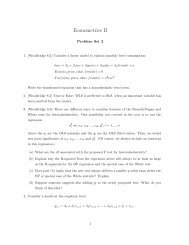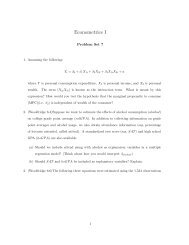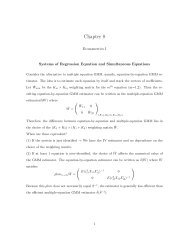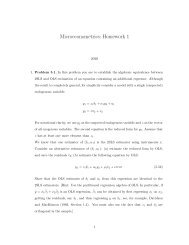Nucleotides and Nucleic Acids
Nucleotides and Nucleic Acids
Nucleotides and Nucleic Acids
- No tags were found...
You also want an ePaper? Increase the reach of your titles
YUMPU automatically turns print PDFs into web optimized ePapers that Google loves.
Chapter 10 . <strong>Nucleotides</strong> <strong>and</strong> <strong>Nucleic</strong> <strong>Acids</strong>b. c. Moving from hexose to ribose to deoxyribose there is a decrease in the number of hydroxylgroups. DNA is much more stable to alkaline hydrolysis than RNA because it lacks a 2’hydroxyl, which in RNA can attack nearby phosphodiester linkages. One could imagine hexosesbeing even worse in this regard. The use of a hexose in place of a ribose might make packagingof DNA more difficult. The presence of additional hydroxyl groups would require more exposureto water molecules. Further, there would be an increases likelihood that unwanted sidereactions involving hydroxyl groups occur.14. Phosphate groups are also integral parts of nucleotides, with the second <strong>and</strong> thirdphosphates of a nucleotide linked through phosphoric anhydride bonds, an importantdistinction in terms of the metabolic role of nucleotides.a. What property does a phosphate group have that a nucleoside lacks?b. How are phosphoric anhydride bonds useful in metabolism?c. How are phosphate anhydride bonds an advantage to energetics of polynucleotidesynthesis?Answer: a. The addition of phosphates will further increase the water solubility of nucleosidesby adding negative charge.b. c. Phosphoanhydride bonds are strongly exergonic <strong>and</strong> their hydrolysis can be used to drivereactions including polynucleotide synthesis.15. The bases of nucleotides <strong>and</strong> polynucleotides are “information symbols.” Theircentral role in providing information content to DNA <strong>and</strong> RNA is clear. Whatadvantages might bases as “information symbols” bring to the roles of nucleotides inmetabolism?Answer: In metabolism, nucleotides are used both to energize compounds <strong>and</strong> to tag them forspecific metabolic fates. For example, glucose destined for storage in glycogen is converted toUDP-glucose. In lipid metabolism, CTP plays a role in activation of phospholipids. Finally, GTPis used in protein synthesis <strong>and</strong> signal transduction pathways.16. Structural complementarity is the key to molecular recognition, a lesson learned inChapter 1. The principle of structural complementarity is relevant to answeringproblems 5, 6, 7, 11, 12, <strong>and</strong> 15. The quintessential example of structuralcomplementarity in all of biology is the DNA double helix. What features of the DNAdouble helix exemplify structural complementarity?Answer: Structural complementarity of double-str<strong>and</strong>ed DNA is due to complementary basepairs. The fact that bases pair allows for efficient replication <strong>and</strong> repair of DNA. Even in thecase of double-str<strong>and</strong>ed breaks, repair mechanisms based on homologous recombination canrejoin DNA molecules.Questions for Self Study1. Fill in the blanks. The two basic kinds of nucleic acids are <strong>and</strong> . They are composedof building blocks termed ; however, the building blocks are not identical for the two kinds ofnucleic acids. One contains the five carbon sugar whereas the other has a modified form ofthis sugar or . The building blocks all contain nitrogenous bases attached to the sugar bybonds. The nitrogenous bases are either derivatives of the 6-membered heterocyclic ringcompound or of purines, a compound composed of a 6-membered heterocyclic ring with a 5-membered ring fused to it. The two common purines are <strong>and</strong>. The 6-membered heterocyclic ring compounds include , , <strong>and</strong> . A ring compoundattached to a sugar is termed a .2. Answer True or Falsea. ATP is an example of a deoxynucleoside triphosphate .b. cAMP is a 3'-5' cyclic form of AMP .c. The α phosphate of GTP is the phosphate closest to the sugar moiety .d. The only biological function of dCTP is as a building block in synthesis of153
















